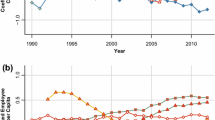Abstract.
This paper develops and estimates an empirical model of the interplay between fertility and economic development. Using panel data, this study finds that a one-percent decrease in population growth increases GDP per capita growth by more than three percent. In addition, because families with low levels of human capital choose to have more children, income per capita grows faster in developed countries than in developing countries. Finally, this study shows that the estimates of the interplay between fertility and output obtained from single cross-country regressions are biased downward because that method of estimation is unable to control for unobservable country effects and measurement errors. The neoclassical approach fails to account for these effects. The present study contributes to the now-standard growth model, and provides a better description of international differences in standards of living.
Similar content being viewed by others
Author information
Authors and Affiliations
Additional information
Received: 25 March 1998/Accepted: 11 June 1999
Rights and permissions
About this article
Cite this article
Ahituv, A. Be fruitful or multiply: On the interplay between fertility and economic development. J Popul Econ 14, 51–71 (2001). https://doi.org/10.1007/s001480050159
Issue Date:
DOI: https://doi.org/10.1007/s001480050159




